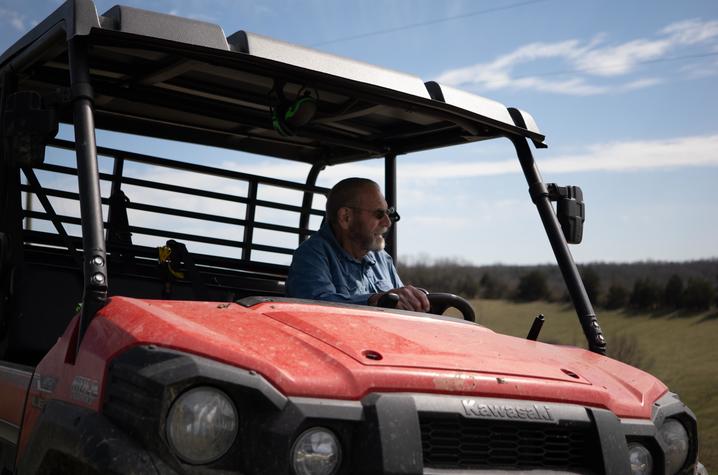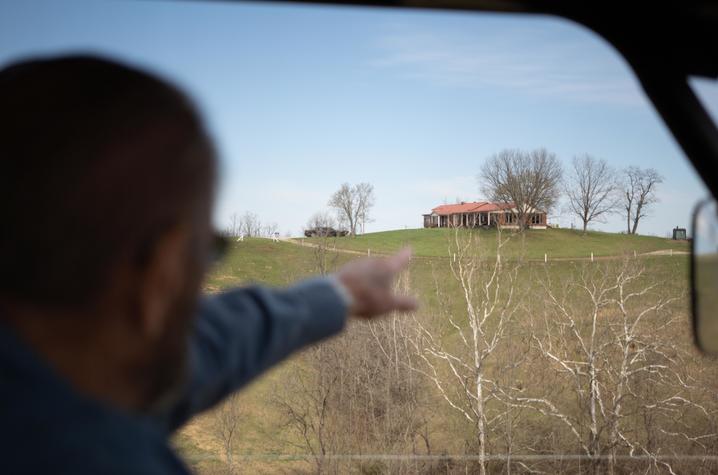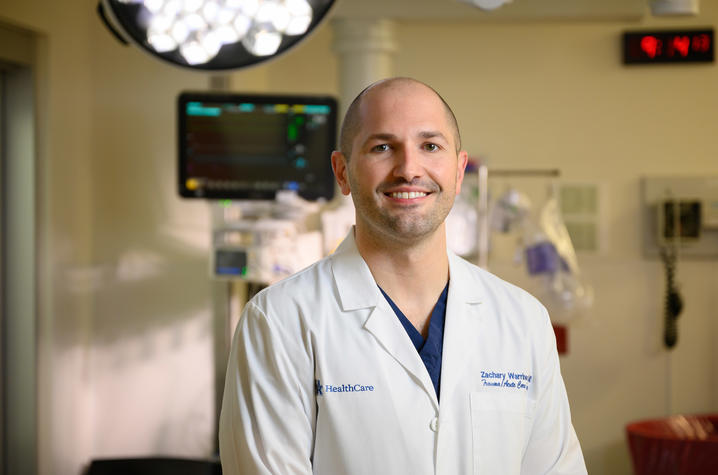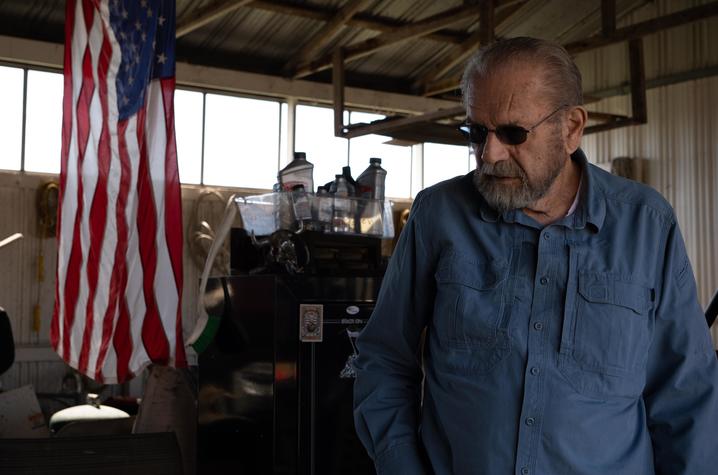Crushed by ATV, Owenton man saved by UK HealthCare trauma team
LEXINGTON, Ky. (Sept. 9, 2024) — Mowing the lawn was one of the least strenuous things Howard Galbreath enjoyed doing.
He may have been 81, but that hadn’t slowed Galbreath from cutting down trees, chopping firewood and other active work on the Owenton, Kentucky, farm he shares with his daughter, son-in-law and grandson.
So, on a sunny June morning in 2022, he didn’t think twice about jumping on his mower to get an early start on the grass.
This time, though, that routine activity went horribly wrong.
Midway up a small hill, the mower blades got stuck. Galbreath shrugged — “no big deal,” he said — and walked to get his ATV. It was equipped with a winch, which can be used to pull stuck vehicles. He’d used both pieces of equipment before and wasn’t worried.
But as Galbreath kicked the ATV into four-wheel drive, one of the tires spun on loose gravel. This toppled the vehicle down the hill — along with Galbreath.
“The only thing I could think of was, ‘How am I going to get this thing off me?’” Howard said.
Because of the angle of the ridge, the four-wheeler rolled off Galbreath on its own. But the damage it did in those couple seconds was extensive. His whole right side was crushed.
Fast response
“I know I’m hurt bad,” Galbreath remembers thinking.
The average ATV weighs about 700 pounds. That amount of pressure coming down onto a human body is often fatal.
Miraculously, Howard was able to get up, stumble back to the lawnmower, and retrieve his phone. His daughter, Christie, was home. When she answered Howard’s call, all he could say was, “Christie. Hospital.”
At one point in the ER, Galbreath said he had an out-of-body experience in which he could feel himself in a tube of white light, looking down at his body. He didn’t feel pain. But at the sound of his daughter’s voice, Galbreath thought, “I have to go back.”
That determination and resilience, combined with a rare surgical procedure led by UK HealthCare trauma surgeon Zachary Warriner, M.D., saved Howard’s life.
Galbreath had fractured his clavicle and seven ribs on his right side. Five of those ribs had multiple fractures, creating a “flail chest.” His right lung had also collapsed.
“If you look at his chest X-ray in the ICU the day I met Howard and his family, it was, to be honest, horrible to look at,” Warriner said. “The right side of his chest was just destroyed.”
Within the first day of being at the hospital, Galbreath’s condition worsened. The ribs had become so displaced that doctors worried the second one would lacerate his superior vena cava — the main blood vessel that drains blood to the heart.
Unfortunately, that second rib can be difficult to reach surgically.
“That approach to the second rib is pretty unique,” Warriner said. “It can be a little dangerous because there are major blood vessels and nerves that control motion of the arm and shoulder. … Even for those of us that fix ribs often, the second rib is not something we typically need to approach. But his second rib was a potentially life-threatening fracture.”
While Galbreath was in the hospital, Christie kept telling him to minimize movement. Don’t cough. Don’t laugh. Now, Warriner told Galbreath he could either perform this risky procedure — or he would have to minimize movement for the rest of his life. Else, he’d risk his rib lacerating his superior vena cava — the large vein that carries blood from the upper part of the body to the heart.
“‘I’ve been active my whole life, Doc. I would not make a good invalid,’” Galbreath told Warriner. “I had no doubt in my mind they could fix me up.”
In surgery, Warriner reduced the fractures and inserted plates onto Howard’s ribs to hold them in place. With this stability, the ribs could heal — and avoid puncturing the vena cava. The repaired ribs helped Galbreath to breathe normally again and provided a solid “scaffolding” to improve Howard’s future shoulder mobility.
“Usually a person who’s had all that done to them, go ahead and bury them,” Galbreath said. “Don’t worry about patching them up because they’re dead. It’s hard to wrap my head around what Dr. Warriner had to do.”
Back to the farm
Recovery from surgery was challenging. But Galbreath had his sights set on simple goals: regain the ability to move around his farm like before, and be able to start his chainsaw. The house where the family lives includes two fireplaces and a wood-burning stove — and Galbreath wanted to keep up the firewood supply himself.
“There’s no greater test of shoulder function than rip-starting a chainsaw,” Warriner said.
For Galbreath, lifting more than 30 pounds at first “put me to hurt the next day.” But now, almost two years after the accident, he lifts up to 75 pounds. He still mows the lawn and cuts down trees.
It’s a life he dreamed of for decades. On a trip to California in his 20s, Galbreath met a man who offered him a job as a ranch hand. It didn’t end up happening — but Galbreath couldn’t shake the idea of riding around a bunch of acres, mending fences and working on the land.
Now, that’s a dream he gets to continue living every day, thanks to the life-saving work of Warriner and the UK HealthCare trauma team.
“I told him, ‘Doc, you gave me the gift of life,’” Galbreath said. “That’s the greatest thing you could give me.”
UK HealthCare is the hospitals and clinics of the University of Kentucky. But it is so much more. It is more than 10,000 dedicated health care professionals committed to providing advanced subspecialty care for the most critically injured and ill patients from the Commonwealth and beyond. It also is the home of the state’s only National Cancer Institute (NCI)-designated Comprehensive Cancer Center, a Level IV Neonatal Intensive Care Unit that cares for the tiniest and sickest newborns and the region’s only Level 1 trauma center.
As an academic research institution, we are continuously pursuing the next generation of cures, treatments, protocols and policies. Our discoveries have the potential to change what’s medically possible within our lifetimes. Our educators and thought leaders are transforming the health care landscape as our six health professions colleges teach the next generation of doctors, nurses, pharmacists and other health care professionals, spreading the highest standards of care. UK HealthCare is the power of advanced medicine committed to creating a healthier Kentucky, now and for generations to come.








